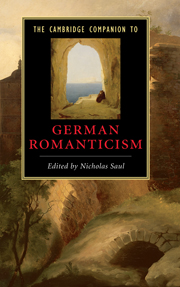Book contents
- Frontmatter
- 1 What is Romanticism, and where did it come from?
- 2 From early to late Romanticism
- 3 Prose fiction of the German Romantics
- 4 The Romantic lyric
- 5 The Romantic drama
- 6 Forms and objectives of Romantic criticism
- 7 Romanticism and Classicism
- 8 Women writers and Romanticism
- 9 The Romantics and other cultures
- 10 Love, death and Liebestod in German Romanticism
- 11 Romantic philosophy and religion
- 12 Romantic politics and society
- 13 Romantic science and psychology
- 14 German Romantic painters
- 15 Romanticism and music
- 16 Transformations of German Romanticism 1830-2000
- Key authors and their works
- Further reading
- Index
5 - The Romantic drama
Published online by Cambridge University Press: 28 September 2010
- Frontmatter
- 1 What is Romanticism, and where did it come from?
- 2 From early to late Romanticism
- 3 Prose fiction of the German Romantics
- 4 The Romantic lyric
- 5 The Romantic drama
- 6 Forms and objectives of Romantic criticism
- 7 Romanticism and Classicism
- 8 Women writers and Romanticism
- 9 The Romantics and other cultures
- 10 Love, death and Liebestod in German Romanticism
- 11 Romantic philosophy and religion
- 12 Romantic politics and society
- 13 Romantic science and psychology
- 14 German Romantic painters
- 15 Romanticism and music
- 16 Transformations of German Romanticism 1830-2000
- Key authors and their works
- Further reading
- Index
Summary
Much of German Romantic drama is experimental, eclectic and derivative. Often it seeks to embrace what in real, empirical terms is not accessible to the finite mind, and it fails aesthetically. Much of it is written or influenced by avid readers of the widest literary traditions who hope to see these fulfilled within the expanding and commodious bounds of a new dramatic form. It is nothing if not ambitious: it seeks to take over from where Schiller left off and has no doubts about its ability to compete with Goethe. In real terms, only its sole great dramatist, Heinrich von Kleist, and its other really interesting figure, Zacharias Werner, had any sense of the formal restraints needed to achieve a dramatic form that could submit to the restrictions of stage performance. The stage history of German Romanticism - an apt mixture of tragedy and farce - is briefly told, and even Kleist's reputation as a dramatist was not secure until the twentieth century. Yet German Romanticism can claim for itself arguably the most influential work of drama criticism of the nineteenth century: August Wilhelm Schlegel's Vorlesungen über dramatische Kunst und Literatur(1809-11; Lectures on Dramatic Art and Literature), which brought the 'Classical' and the 'Romantic' into sharp formal and ideological opposition and enthroned Shakespeare and Calderón as the exemplars of the 'modern' and 'romantic'. This approach stressed formal diversity and experiment, not classical restraint; it called for the primacy of national and religious values. Ludwig Tieck's corpus of Shakespearean criticism sought to integrate Shakespeare into these patterns and it saw the drama and the theatre as the source of national revival.
- Type
- Chapter
- Information
- The Cambridge Companion to German Romanticism , pp. 85 - 100Publisher: Cambridge University PressPrint publication year: 2009
- 1
- Cited by

